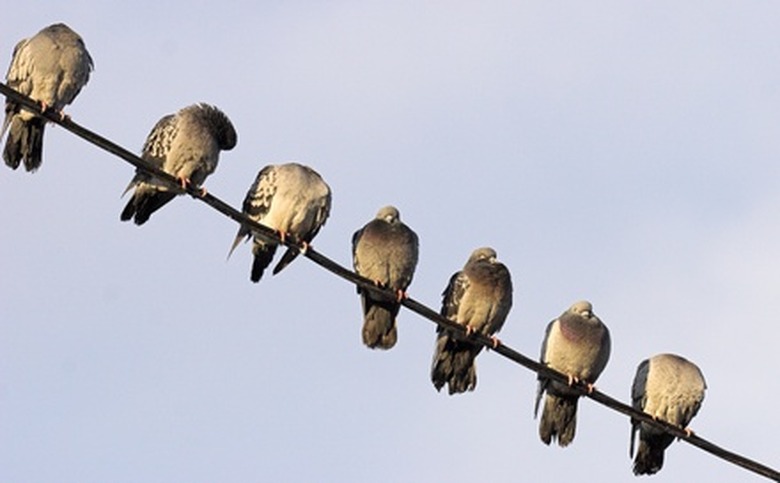Why Do Birds Sit On Electrical Wires?
Seeing birds on power lines is not unusual. The types of birds we see on power lines are called passerines or songbirds. Passeriform is the most significant order of birds with over 5,700 species.
Songbirds can be found on every landmass on the planet except Antarctica and some oceanic islands.
How Birds Perch
How Birds Perch
Songbirds have feet that are adapted to perching on branches or twigs. Their feet don't have feathers and one toe points backward while the other three-point forwards.
Flexor tendons that connect the bird's leg and toes automatically flex and tighten when the bird lands on a perch.
Why Birds Perch
Why Birds Perch
Birds perch to rest, sleep, preen themselves and feed. Birds can sleep on twigs and power lines without falling off due to the powerful locking action of their flexor tendons.
Perching in hard to reach places to sleep helps protect birds from predators while they are vulnerable. For birds, man-made high tension wires like power lines are a similar shape to the structures birds naturally perch on.
Electric Currents
Electric Currents
Electric currents are the movement of charge carrier from one place to another. Charge carriers could be subatomic particles, ions or holes (electron deficiencies). Wire power lines carry electrons from one place to another.
Electric currents move along the path of least resistance from high potential areas to low potential areas. For example, think of the electrical current as a fruit on the top of a tree on a hill, The moment the fruit is released it will follow the easiest path and fall to the ground then roll down the hill.
Defining Electrocution
Defining Electrocution
We define electrocuted as when something is hurt or killed due to a severe electrical shock. Electrocution can occur from being hit by lightning or coming into contact with high or low voltages.
High voltages are those over 1000 volts and more likely to result in death due to tissue and cell damage. Low voltage shocks under 1000 volts can still kill a human but are more likely to result in symptoms such as minor thermal burns and sensations.
Birds on Telephone Wire
Birds on Telephone Wire
Birds don't get electrocuted on power lines because electricity does not move through their bodies when they sit on them. When the bird sits with both its feet on the electrical wire, their legs have an equal electrical potential so the electricity will not move throughout the bird's body.
The bird is, however, endangered if they sit on two different wires simultaneously or they touch a pole and a wire at the same time. In either of these scenarios, the electrical current now has the motivation to move through the bird's body and they may get electrocuted.
Humans and Electrical Wires
Humans and Electrical Wires
Now you may ask, "will touching a power line kill you?" The answer is potentially yes. Humans get hurt by touching electrical currents as the person is typically also touching the ground.
The ground has a low potential and the wires have a high potential, so when a person touches the wire it crate a bridge that allows the **electricity to moves to the lower potential object**, electrocuting the person along the way.
Electricity Tolerance of Different Animals
Electricity Tolerance of Different Animals
Electrical wires are often used to keep people and animals out or in confined areas. Different animals have different resistance to electrical currents. The voltage the fence is set to needs to be altered depending on the type of animals it is being set up for.
For example, bears need a voltage of 5000 to keep them away due to their thick insulating fur while pigs only need 2000 volts as their pink hairless noses will be the first thing to touch the wires.
References
- Project Beak: Perching
- RSPB: Why Don't Birds Fall Off Their Perches When They Sleep
- MIT: How Do Birds Sit on High-Voltage Power Lines Without Getting Electrocuted?
- Merriam Webster: Electrocution
- Journal of Medicine and Life: Electrocutions – Treatment Strategy (Case Presentation)
- Encyclopaedia Britannica: Electric Current
- Encyclopaedia Britannica: Passeriform
- Stafix: Animal Voltage Requirements
Cite This Article
MLA
Jerrett, Adrianne. "Why Do Birds Sit On Electrical Wires?" sciencing.com, https://www.sciencing.com/do-birds-sit-electrical-wires-6592687/. 22 November 2019.
APA
Jerrett, Adrianne. (2019, November 22). Why Do Birds Sit On Electrical Wires?. sciencing.com. Retrieved from https://www.sciencing.com/do-birds-sit-electrical-wires-6592687/
Chicago
Jerrett, Adrianne. Why Do Birds Sit On Electrical Wires? last modified March 24, 2022. https://www.sciencing.com/do-birds-sit-electrical-wires-6592687/
